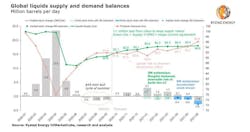Rystad: Glut will build if OPEC+ increases output in January
If OPEC+ output increases as planned in January 2021, the world will face a new 200-million-bbl surplus through May 2021, according to Rystad Energy data.
The OPEC+ group will debate whether to maintain its currently curtailed oil production levels to 2021 or to increase them as planned by nearly 2 million b/d. The existing plan was drafted during the COVID-19 pandemic’s first wave and under a more optimistic forecast for end-year oil demand, which turned out to be too high as the pandemic’s second wave brought new lockdowns globally.
Should OPEC+ fail to amend its existing deal and increase production, the world in January will face its biggest monthly glut since April 2020 with an average daily surplus of 3.1 million bbl for the month. Smaller surpluses would likely continue through May, building a surplus to exceed 200 million bbl for the first 5 months of 2021, before beginning to shrink in June.
Modeling a possible decision by OPEC+ to postpone its production increase, Rystad Energy calculated the effect on global oil balances of 3-month and 6-month extension scenarios.
If OPEC+ postpones its planned January production increase by 3 months, the market will still see consecutive monthly surpluses through May, but the total size will be limited to about 115 million bbl. Should OPEC+ call to extend the current status quo for 6 months, surpluses will end after March, leaving behind a smaller, 3-month glut of just 90 million bbl, which will be erased by the end of June due to deficits coming from April.
“We believe keeping the current agreement in place – which calls for raising target production by 1.9 million b/d from January 2021 – could send Brent back down to $40/bbl or lower. A 3-month extension would only provide marginal support to prices, but would help to establish $50 as a sturdier floor, while a 6-month extension could help to meaningfully deplete the storage overhang and supercharge prices into the mid-$50s,” said Bjornar Tonhaugen, Rystad’s head of oil m.
In a way, OPEC+ is already locked into extending its current cuts for some period in 2021 and probably knows it will be punished by the market if it doesn’t do so, Tonhaugen said.
The oil demand recovery trajectory is the primary consideration of OPEC+ as it debates whether to modify its supply regime. Rystad Energy expects the second wave of COVID-19 cases to continue to surge through the end of 2020 and have a residual effect on oil demand in 2021, causing a slow recovery. At present, Rystad expects demand for total liquids will not surpass 93 million b/d before yearend 2020.
Should the OPEC+ cut extension go through, the primary benefactor will be the most flexible marginal supply source on the market – shale. The past few months demonstrated that $40 Brent was enough to slow oil production growth prospects in the US shale patch, but at the same time it was clearly not a high enough price environment to allow players to thrive, as evidenced by the increase in consolidation and bankruptcy activity.
“The breakup of the OPEC+ deal in March 2020, when participants failed to agree on an additional 1.5 million b/d of cuts, sparked a full collapse in oil prices with a drop of $10/bbl from the time the decision was made public until markets opened the following Monday. These were of course special circumstances, but a vote of no confidence from OPEC+ this week would surely be crushing for oil prices, though perhaps to a milder degree this time,” Tonhaugen said.
However, there is an upside to the forecasts, especially for second-quarter 2021, as Rystad has not yet included any material positive effect from vaccines on oil demand in first-half 2021 as the roll-out of vaccination campaigns remains uncertain due to regulatory approvals.
As many expect first vaccinations will be reserved for healthcare professionals and the elderly, a slow and gradual roll-out of vaccination campaigns will take time before resulting in lockdown liftings and behavioral change in the wider population.
